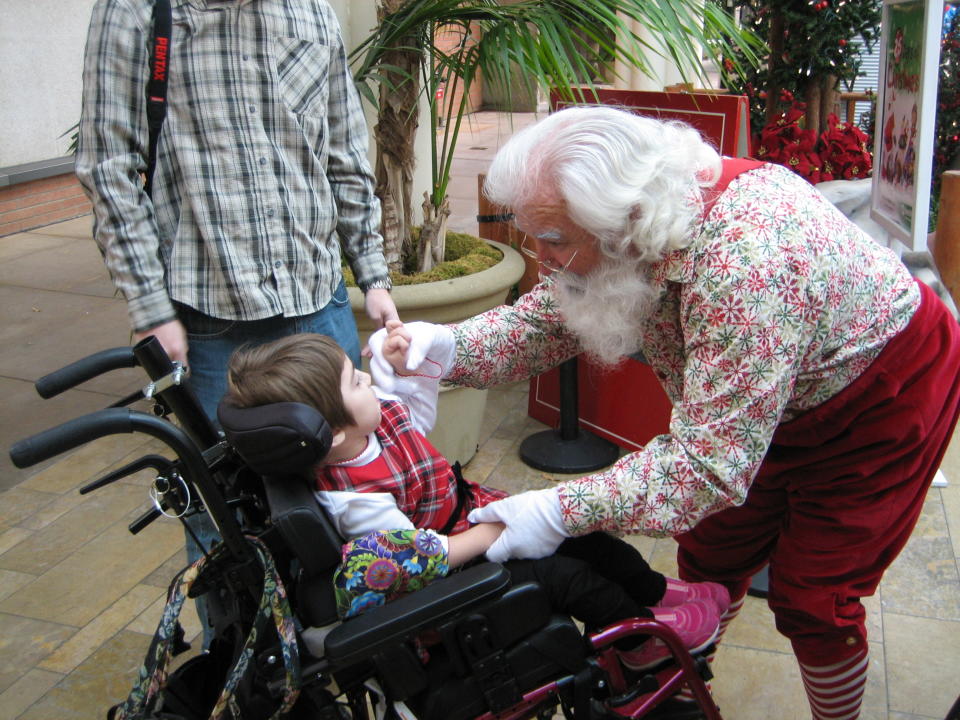From dimmed lights to smaller crowds, sensory-friendly Santas are giving kids with autism a more soothing holiday

Visiting Santa at the mall may not be anyone’s idea of a soothing activity, but for people with autism or other special needs, like Sherri Moulton’s 8-year-old son, George, it can be hugely overwhelming and stressful. The crush of the crowd, the din, the long lines, the flashing lights — it all creates an unpredictable, highly fraught environment that can upset or cause discomfort for a child with a sensory disorder. “Overstimulation often leads to massive meltdowns,” Moulton tells Yahoo Lifestyle of the holiday chaos.
That’s why she and other parents are turning to events that celebrate the season while being sensitive to kids with sensory disorders, with limited stimulation, wait time and noise ensuring a more subdued and calm atmosphere. Since 2015, shopping centers across the country have been offering sensory-friendly Santa Cares visits, a collaboration between autism advocacy organization Autism Speaks and Cherry Hill Programs, the experiential photography company specializing in the festive backdrops that populate malls each holiday season.
Video: Kids With Autism Get Sensory Friendly Visit With Santa
From Rapid City, South Dakota, to Orlando, Florida, Santa Cares is designed to be inclusive and accommodating to those with special needs, while also raising awareness and making families “feel comfortable, understood and accepted,” says Valerie Paradiz, PhD, vice president of services and supports at Autism Speaks.
“Families can expect to meet a specially trained Santa, who understands how to interact with children with special needs, taking cues from a parent or caregiver who knows the child’s preferences,” Paradiz tells Yahoo Lifestyle. “Because Santa visits are by reservation, families can avoid waiting in lines, which can be one of the more challenging aspects of these types of experiences.”

For Moulton and her son, the sensory-friendly holiday experience has been a game-changer.
“In a regular setting, visits with Santa would be next to impossible due to the chaos and crowds,” she says. “[But] sensory-friendly Santa visits are done when the mall is closed, keeping crowds to a minimum. They turn off all the music, and rather than waiting in a long line, you're issued a number and a time to come back, reducing the time you have to stand around waiting. Therapeutic dogs are brought in to create a calming distraction for the children.”
As always, Santa plays a crucial role. Paradiz says the Santas who participate are trained to “remain flexible,” adding, “Not every child has the same abilities, so Santa can move around behind his chair, or even kneel to connect with a child.”
According to Moulton, being able to give specific instructions to Santa — such as waving rather than hugging a child with an aversion to touch, or speaking softly to someone sensitive to sound — paves the way for a more pleasant experience.
“George is always delighted when Santa knows his name, and I think it makes him feel welcome and comfort in an unfamiliar environment,” she says. “Sensory-friendly activities allow us to enjoy a bit of normalcy during the holidays — like visits with Santa — that we otherwise wouldn't get to experience."

While Santa is currently in high demand — with 747 Santa Cares events running at 582 shopping destinations across the U.S. and Canada this year — other holidays aren’t excluded. Autism Speaks and Cherry Hill Programs also run Bunny Cares, a sensory-friendly experience come Easter.
Paradiz also says it’s “important to remember those with sensory sensitivities are impacted year-round,” whether they are in a shopping mall or not.
“Always be mindful of noise and lights and be understanding of the mechanisms people with autism may use to feel more comfortable, like headphones,” she says. “Additionally, it is equally useful for the public to understand hyposensitivity and how people with autism sometimes seek out sensory input to remain calm. For some, awareness of body space may appear different from general norms, or they may appear to be impulsive as they seek out input. Patience, understanding and an open mind are key.”
Read more from Yahoo Lifestyle:
Firefighter comforts preschooler with autism in sweet photo: ‘It warmed my heart’
Mall Santa Claus fired after posing for 'inappropriate' gag photos
Family fights back after being told to take down Christmas decorations: 'We're not going to do it'
Follow us on Instagram, Facebook and Twitter for nonstop inspiration delivered fresh to your feed, every day.

